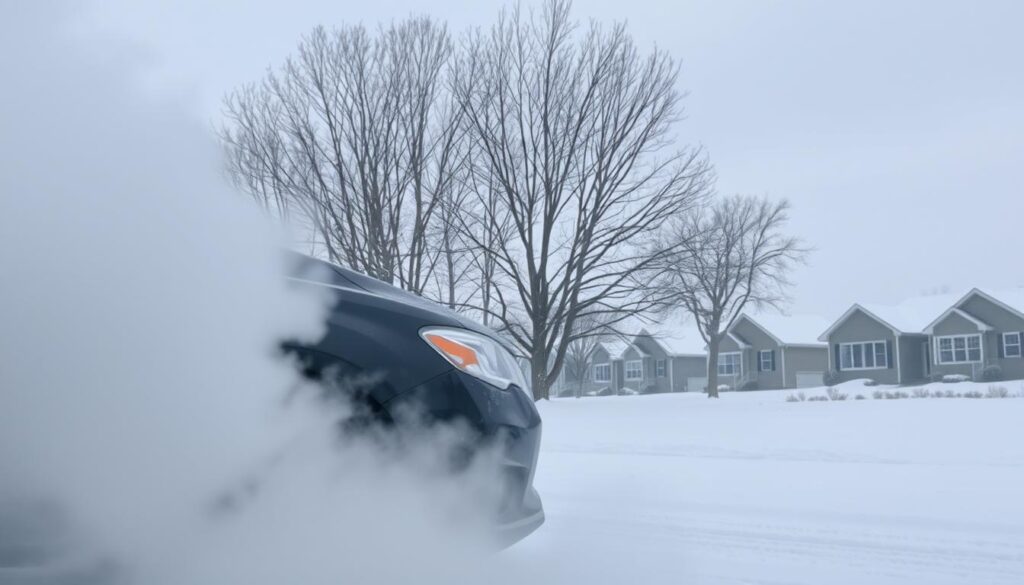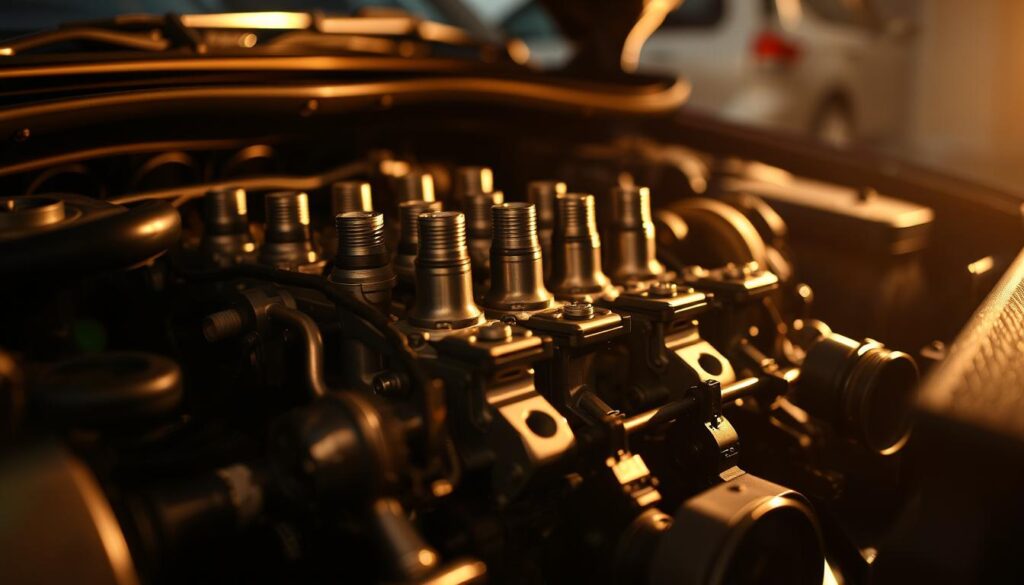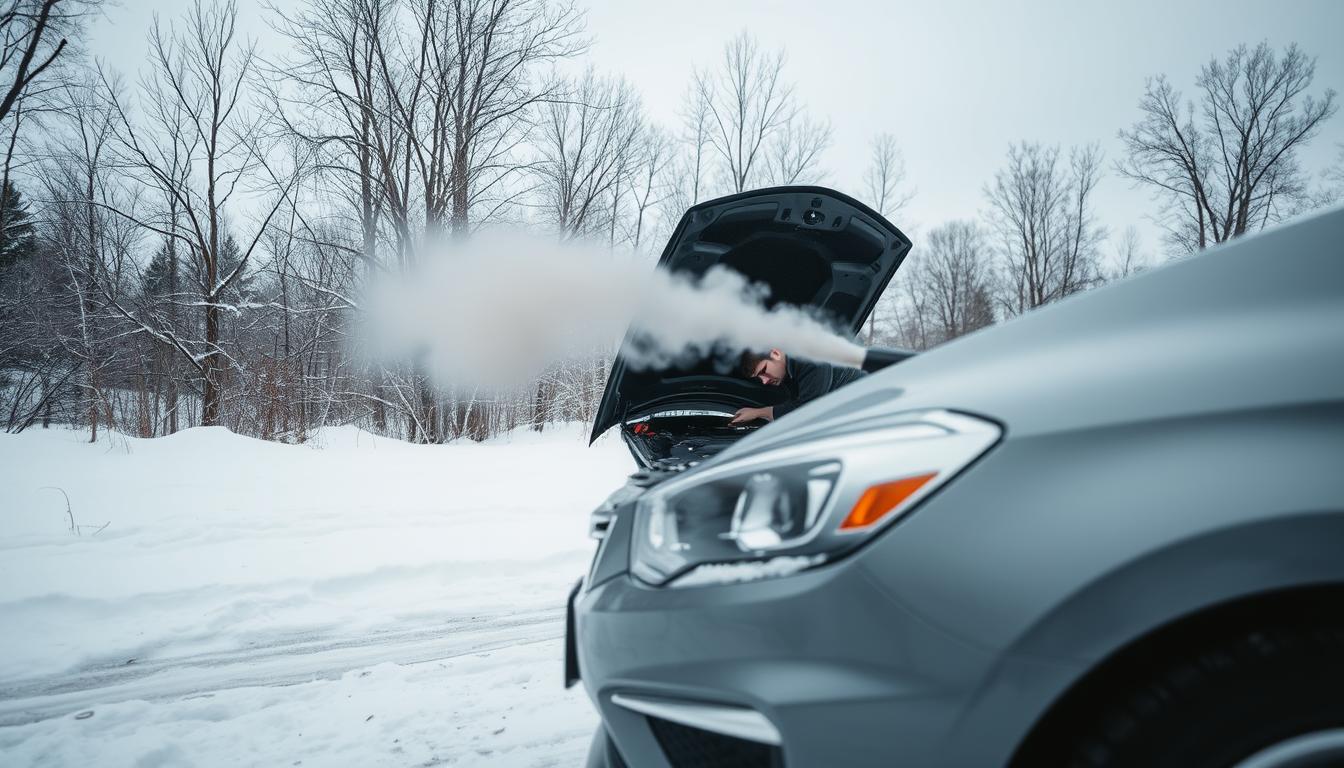Surprising fact: many engines spike near 1500 RPM at startup on a frosty morning, then drop to about 800 RPM as they warm.
We’ll set expectations for that first minute after you turn the key. A brief high rev is a built-in cold-start strategy. It helps the engine warm faster and run clean.
Still uneasy? A persistent high rev or choppy run after warm-up points to real issues. Common causes include a vacuum leak, a faulty booster line, a stuck EGR valve, or a leaky fuel injector that clears as the engine heats.
Simple driveway checks can save time. Look for brittle hoses, listen for hissing that means unmetered air, and note dash lights — multiple warnings often come from a shared sensor like a rear speed sensor, not coils or plugs.
We’ll also show when a reset — disconnecting the battery and reseating ECM connectors — can help restore clean signals and improve performance.
Key Takeaways
- Brief high RPMs at startup are normal as the engine warms.
- Transient rough running that smooths out often ties to fuel or injector quirks.
- Persistent high revs or stalling points to vacuum leaks or EGR faults.
- Multiple dash lights can stem from a shared sensor, not always the engine.
- A battery disconnect and reseating ECM connectors can fix poor electrical signals.
Cold-weather idle in the United States: what’s normal and what’s not right now
Engines respond to low temperatures with a controlled speed rise at first ignition. This is a designed behavior. Fuel vaporizes less easily in chilly air, so the control unit adds more fuel and raises RPM briefly.
Typical pattern: a quick flare near 1500 RPM that settles to about 800 RPM within a few minutes as the mixture stabilizes and the engine warms.
If that high speed persists or the revs hunt up and down after warm-up, treat it as a signal of a problem. Common airflow-related causes include a cracked vacuum hose, a leaking brake booster vacuum line, or an EGR valve stuck open.
- Expect a short high RPM burst that calms as the engine reaches temperature.
- Unmetered air leaks keep RPM elevated — check hoses and booster lines.
- If abnormal behavior continues after warming, schedule a professional check to avoid damage.
| Condition | Normal Response | Action if persistent |
|---|---|---|
| High RPM at startup | Rise to ~1500 RPM, then drop to ~800 | Monitor for >5 minutes; inspect hoses |
| Idle stays high | Not normal | Check vacuum lines, booster, EGR; service soon |
| Hunts or stalls after warm | Not normal | Seek professional diagnosis to protect engine |
Is it normal for cars to idle rough when cold?

A brief unsettled run at startup can be normal, but the line between expected and problematic is clear.
Normal cold-start behavior includes a short rise in rpm and a little vibration. The control system adds extra fuel and air to help combustion. This helps droplets vaporize in chilly air and get the engine running smoothly.
When the issue is worth checking
If the speed and shake don’t calm toward normal within a few minutes, investigate. Persistent misfire or roughness after the engine is warm is not just the weather.
“Short roughness for a minute or two is expected; continued symptoms need a diagnosis.”
Common faults to rule out
- Split vacuum hose or leaking booster diaphragm letting unmetered air upset the mix.
- Stuck-open EGR valve that dilutes the intake and creates a rhythmic stumble.
- Leaky injector that pours extra fuel until temperatures stabilize.
We recommend a quick visual hose check and a listen for hissing. If symptoms persist, get a professional scan and repair.
Why is my car idling rough but drives fine?

A vehicle that feels shaky at idle yet drives smoothly is a common puzzle for drivers. We see the same pattern often: a brief stumble at first ignition, then normal performance once you move.
Leaky fuel injector
A small injector seep can puddle fuel in a cylinder. The extra fuel misfires at low speed but vaporizes as the engine warms. That clears the stumble and restores smooth running.
Cold-start spark and ignition
Marginal coils or worn plugs struggle at low rpm. Under load, higher revs mask a weak spark and the vehicle feels normal.
Air, sensors, and vacuum inputs
Cracked hoses, a bad booster line, or a sticking EGR upset idle quality. Listen for hissing and check for fuel odors after an overnight sit.
What the ECU is doing
The ECU enriches the mixture and raises speed when cold. That strategy can hide small faults once airflow rises on the road.
“Log when the stumble starts, how long it lasts, and if it returns at stoplights — that detail speeds diagnosis.”
- Inspect hoses and listen for leaks.
- Note smell of fuel after parking overnight.
- Record occurrence timing and duration for the shop.
Why does my car idle rough when cold in winter USA: common causes and DIY checks
Let’s run through fast, hands-on checks that point to an air leak, fuel seep, or spark issue. Note RPM behavior at startup — a quick flare near 1500 RPM that settles toward ~800 in a few minutes is normal. If it stays high, act.
Check for vacuum leaks
Look and feel for brittle or cracked hoses. Listen for a steady hissing around the intake and brake booster hose.
Tap the EGR valve lightly and watch for a change in speed — a stuck valve can mimic a leak. Verify connectors are secure.
Fuel-related causes
Sniff for raw fuel near the rail after an overnight sit. A small injector seep can create a brief stumble that vanishes as the engine warms.
Old gas and colder weather blends change volatility and can lengthen the warm-up window slightly.
Spark and coils
Inspect plugs and coils for cracks, corrosion, or heavy carbon. Bad spark at low rpm shows as a stumble but often hides once the vehicle is moving.
Note: Multiple dash lights usually point to a sensor network issue — not all spark parts failing at once.
Reset ECM connections
Disconnect the battery, release the ECM locking tabs, inspect for corrosion, then reconnect firmly. Let the engine re-learn idle for a few drive cycles.
When to visit a service center
Bring it in if high speed persists instead of tapering, if roughness continues after warm-up, or if drivability worsens on the road. Those signs need a shop scan and pressure/scan tests.
“If the RPM spikes near 1500 and won’t settle toward ~800 after several minutes, prioritize an air-leak check.”
| Symptom | Likely cause | Quick DIY check |
|---|---|---|
| High RPM that stays up | Vacuum leak / booster hose | Inspect hoses, listen for hissing |
| Brief stumble then clears | Leaky injector / stale fuel | Smell fuel, consider fresh gas |
| Rough at idle but drives fine | Weak spark or sensor input | Check plugs/coils; scan for codes |
Does cold weather affect idle?
Low air temps change fuel behavior and nudge the engine to run faster at start. Fuel vaporizes less easily in chilly air, so the control unit enriches the mix and raises speed briefly.
What happens next: the richer mixture helps ignition. RPM often spikes near 1500 and drops toward ~800 as the engine heats and the mixture leans out.
Very cold conditions can extend that period. Larger engines or older sensors may keep elevated speed a little longer. If the rpm does not fall as the vehicle warms, look for unmetered air leaks—brittle hoses or a failed booster line—or a sticking EGR valve.
Practical tip: give a short, gentle warm-up and then drive lightly. That helps the engine reach operating temperature while the control system finishes its cold-start routine.
| Effect | Typical response | Action if prolonged |
|---|---|---|
| Fuel vaporizes poorly | Higher initial speed (~1500 rpm) | Short warm-up; monitor |
| Control unit enriches mix | Smoother combustion as temp rises | Check sensors if not settling |
| Very low temps | Longer high speed period | Inspect hoses, EGR, booster line |
| Vehicle runs fine after warm | Normal behavior | No action unless symptoms return |
Conclusion
Conclusion
We’ll close with clear next steps. A short rise to about 1500 RPM that falls toward ~800 as the engine warms is normal in cold weather. That pattern shows the control system is enriching the mixture and raising speed to stabilize combustion.
If high revs or persistent stumble continue after warm-up, treat them as real issues. Likely causes include vacuum leaks, a sticking EGR, or a small injector seep. A weak spark or marginal ignition can make idle feel bad but hide once you drive.
Do a safe DIY check: inspect hoses, sniff for fuel, and reseat ECM connectors after disconnecting the battery. If symptoms persist, book time at a trusted service center.
FAQ
Is it normal for a vehicle to idle rough during cold starts?
Short answer — yes, some roughness at startup is common. Colder air makes fuel harder to vaporize, so engines use a richer mixture and a higher idle to warm up. That helps combustion at low temperatures. If roughness clears quickly as the engine warms, it’s usually normal. If it lingers, get it checked.
What cold-start behavior should I expect in U.S. winter conditions?
Engines often run richer and rev a bit higher right after start. That’s the computer compensating for dense, cold air and slower fuel vaporization. You may hear a choppy idle, mild shaking, or a short-lived higher RPM until coolant and intake air warm up.
When is rough idle not normal and needs attention?
If roughness continues after warm-up, or if you notice stalling, loss of power, or a check-engine light, don’t ignore it. Persistent issues can point to vacuum leaks, failing sensors, misfires, or fuel problems that need diagnosing.
Why might the engine run rough at idle but feel fine while driving?
Under load and at higher RPMs the engine masks small faults. A leaky injector or weak spark can cause rough startup that smooths once the engine spins faster. Also, the ECU’s warm-up strategy can hide minor problems while cruising.
Could vacuum leaks cause cold rough idle?
Yes — cracked vacuum hoses, faulty intake gaskets, a leaking brake booster line, or an EGR valve can upset the idle, especially at low temperatures. Cold makes rubber brittle, so inspect lines and connections for cracks or loose clamps.
How does fuel quality affect winter idle?
Winter gasoline blends and old, stale fuel can worsen cold starts. Injectors that seep or partially clog may misdeliver fuel until the engine heats and flow evens out. Draining and refilling with fresh, season-appropriate fuel helps in many cases.
Are spark plugs and coils likely culprits for cold roughness?
Yes — worn plugs, bad wires, or weak coils cause misfires that show up strongest at idle. Cold increases resistance and can amplify weak ignition. Inspect and replace plugs or coils if symptoms persist, and watch for dash codes before assuming something else.
Can sensors or the ECU strategy cause rough idle only when cold?
Absolutely. The mass airflow sensor, coolant temp sensor, or intake air temp sensor feed the ECU. Incorrect readings prompt improper fueling. Also, the ECU runs a cold-start strategy — richer mixture and different timing — that can reveal underlying faults until it reverts to normal mapping.
What quick DIY checks can we do before visiting a shop?
Inspect vacuum hoses for cracks or loose clamps. Smell for fuel and check for wet injectors. Swap questionable spark plugs or inspect coils. Clean the MAF sensor and throttle body if dirty. Avoid aggressive repairs if unsure — simple checks often pinpoint obvious problems.
When should we go to a service center?
Bring it in if roughness persists after warm-up, the idle stays high, the engine stalls, or a check-engine light appears. Professional diagnostics catch intermittent faults, vacuum leaks, and sensor issues faster — and prevent costly damage later.
Will disconnecting the battery help reset cold-start idle issues?
Rebooting the ECM can clear learned fueling and idle settings and sometimes improve behavior. After reconnecting, the computer relearns — but reseat connectors and avoid repeatedly disconnecting the battery. If problems return, diagnostics are needed.
How do winter temperatures change fuel-air mixing and idle speed?
Cold air is denser, which alters the fuel-air ratio. Engines compensate by adding fuel and raising idle speed to maintain smooth combustion. That transitional period is when most cold-start roughness appears — and usually fades as temperatures normalize.
Recent Posts
When Did Cassette Tapes Come Out in Cars: A Retro Revolution
Blast back to the past and discover when cassette tapes first rocked the car audio scene, sparking a retro revolution in in-car entertainment!
Discover if your leased car is actually an asset or just a depreciating expense! Let's dive into the real financial picture behind your lease.


